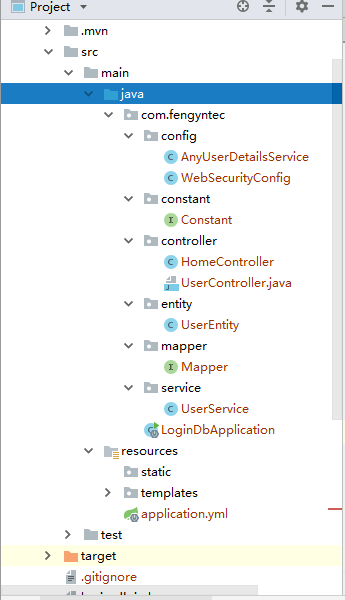1 项目结构图

2 AnyUserDetailsService
package com.fengyntec.config;
import com.fengyntec.entity.UserEntity;
import com.fengyntec.service.UserService;
import org.springframework.beans.factory.annotation.Autowired;
import org.springframework.security.core.authority.SimpleGrantedAuthority;
import org.springframework.security.core.userdetails.User;
import org.springframework.security.core.userdetails.UserDetails;
import org.springframework.security.core.userdetails.UserDetailsService;
import org.springframework.security.core.userdetails.UsernameNotFoundException;
import org.springframework.stereotype.Service;
import java.util.ArrayList;
import java.util.List;
@Service
public class AnyUserDetailsService implements UserDetailsService {
@Autowired
private UserService userService;
@Override
public UserDetails loadUserByUsername(String username) throws UsernameNotFoundException {
UserEntity userEntity = userService.getByUsername(username);
if (userEntity == null){
System.out.println("用户不存在");
}
List<SimpleGrantedAuthority> simpleGrantedAuthorities = createAuthorities(userEntity.getRoles());
UserDetails userDetails = new User(userEntity.getUsername(),userEntity.getPassword(),simpleGrantedAuthorities);
return userDetails;
}
private List<SimpleGrantedAuthority> createAuthorities(String roleStr){
String[] roles = roleStr.split(",");
List<SimpleGrantedAuthority> simpleGrantedAuthorities = new ArrayList<>();
for (String role : roles) {
simpleGrantedAuthorities.add(new SimpleGrantedAuthority(role));
}
return simpleGrantedAuthorities;
}
}
3 WebSecurityConfig
package com.fengyntec.config;
import org.springframework.beans.factory.annotation.Autowired;
import org.springframework.context.annotation.Configuration;
import org.springframework.security.config.annotation.authentication.builders.AuthenticationManagerBuilder;
import org.springframework.security.config.annotation.web.builders.HttpSecurity;
import org.springframework.security.config.annotation.web.configuration.EnableWebSecurity;
import org.springframework.security.config.annotation.web.configuration.WebSecurityConfigurerAdapter;
import org.springframework.security.crypto.bcrypt.BCryptPasswordEncoder;
@EnableWebSecurity
@Configuration
public class WebSecurityConfig extends WebSecurityConfigurerAdapter {
@Autowired
private AnyUserDetailsService anyUserDetailsService;
@Override
protected void configure(HttpSecurity http) throws Exception {
http
.csrf().disable()
.authorizeRequests()
.antMatchers("/user/**").hasRole("USER")
.antMatchers("/admin/**").hasRole("ADMIN")
.anyRequest().authenticated()
.and()
.formLogin()
.loginPage("/login.html")
.permitAll()
;
}
/**
* 添加 UserDetailsService, 实现自定义登录校验
*/
@Override
protected void configure(AuthenticationManagerBuilder builder) throws Exception{
builder.userDetailsService(anyUserDetailsService).passwordEncoder(new BCryptPasswordEncoder());
}
}
4 Constant
package com.fengyntec.constant;
public interface Constant {
public static String ROLE_USER = "ROLE_USER";
}
5 HomeController
package com.fengyntec.controller;
import com.fengyntec.service.UserService;
import com.google.gson.Gson;
import org.springframework.beans.factory.annotation.Autowired;
import org.springframework.security.access.annotation.Secured;
import org.springframework.security.authentication.UsernamePasswordAuthenticationToken;
import org.springframework.security.config.annotation.method.configuration.EnableGlobalMethodSecurity;
import org.springframework.security.core.Authentication;
import org.springframework.security.core.GrantedAuthority;
import org.springframework.security.core.authority.SimpleGrantedAuthority;
import org.springframework.security.core.context.SecurityContextHolder;
import org.springframework.web.bind.annotation.GetMapping;
import org.springframework.web.bind.annotation.RestController;
import java.util.ArrayList;
import java.util.List;
@RestController
@EnableGlobalMethodSecurity(securedEnabled = true)
public class HomeController {
@Autowired
private UserService userService;
@GetMapping("/hell")
public String hello(SecurityContextHolder holder){
System.out.println(holder.toString());
return new Gson().toJson(holder);
}
@GetMapping("admin")
public String admin(){
return "admin";
}
@GetMapping("/vip")
@Secured("ROLE_VIP")
public String vip(){
return "仅限于vip用户查看";
}
@GetMapping("/openVip")
public boolean uodateVip(){
Authentication auth = SecurityContextHolder.getContext().getAuthentication();
List<GrantedAuthority> updateAuthority = new ArrayList<>(auth.getAuthorities());
updateAuthority.add(new SimpleGrantedAuthority("ROLE_VIP"));
Authentication newAuth = new UsernamePasswordAuthenticationToken(auth.getPrincipal(),auth.getCredentials(),updateAuthority);
SecurityContextHolder.getContext().setAuthentication(newAuth);
return true;
}
}
6 UserEntity
package com.fengyntec.entity;
import lombok.Data;
@Data
public class UserEntity {
private Long id;
/**
* 账号
*/
private String username;
/**
* 密码
*/
private String password;
/**
* 昵称
*/
private String nickname;
/**
* 权限
*/
private String roles;
}
7 Mapper
package com.fengyntec.mapper;
import com.fengyntec.entity.UserEntity;
import org.apache.ibatis.annotations.Insert;
import org.apache.ibatis.annotations.Param;
import org.apache.ibatis.annotations.Select;
import org.springframework.stereotype.Component;
@org.apache.ibatis.annotations.Mapper
@Component
public interface Mapper {
@Insert("insert into user(username, password, nickname, roles) values(#{username}, #{password}, #{nickname}, #{roles})")
int insert(UserEntity userEntity);
@Select("select * from user where username = #{username}")
UserEntity selectByUsername(@Param("username") String username);
}
8 UserService
package com.fengyntec.service;
import com.fengyntec.constant.Constant;
import com.fengyntec.entity.UserEntity;
import com.fengyntec.mapper.Mapper;
import org.springframework.beans.factory.annotation.Autowired;
import org.springframework.context.annotation.Primary;
@org.springframework.stereotype.Service
@Primary
public class UserService {
@Autowired
private Mapper mapper;
public boolean insert(UserEntity userEntity){
String username = userEntity.getUsername();
if (exist(username)){
return false;
}
userEntity.setRoles(Constant.ROLE_USER);
int result = mapper.insert(userEntity);
return result == 1 ;
}
private boolean exist(String username){
UserEntity userEntity = mapper.selectByUsername(username);
return userEntity != null;
}
public UserEntity getByUsername(String username) {
return mapper.selectByUsername(username);
}
}


